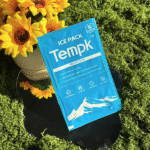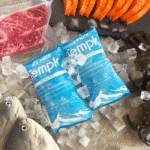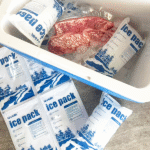Cuando envía bienes perecederos, Mantener una temperatura estable es fundamental para garantizar la integridad del producto.. Paquetes de hielo seco, Hecho de dióxido de carbono sólido (Co₂), offer a powerful solution to keep items frozen during transit. As the cold chain logistics industry evolves in 2025, understanding the latest regulations, Mejores prácticas, and innovative trends in using dry ice for shipping is crucial for compliance and safety.
Cuáles son Paquetes de hielo seco para el envío?
Dry ice packs are sheets, bloques, or pellets of solid CO₂, designed to keep temperature-sensitive products at ultra-low temperatures. A diferencia del hielo convencional, dry ice sublimates directly into gas without leaving behind any liquid residue. This feature makes it ideal for shipping items that require freezing, como los productos farmacéuticos, muestras biológicas, and certain perishable foods.
Why Use Dry Ice for Shipping?
Dry ice packs are an excellent choice for shipping due to their unique properties, providing several advantages over traditional cooling methods.
-
Poder de enfriamiento duradero: Dry ice sublimates at a much slower rate than regular ice, ensuring your goods remain cold for longer durations.
-
No Moisture Runoff: Since dry ice does not melt into water, there’s no risk of water damage to sensitive items.
-
Ideal for Extended Transit: Para envíos que duren más de 48 horas, dry ice is often the preferred choice for keeping goods frozen.
2025 Regulations for Shipping Dry Ice
Shipping dry ice is subject to strict regulations due to its classification as a hazardous material. En 2025, the following key regulations must be adhered to when shipping dry ice:
-
Número de la ONU: Packages containing dry ice must be clearly labeled with the UN number “1845.”
-
Clase 9 Etiqueta de peligro: una clase 9 hazardous materials label must be affixed to the package.
-
Declaración de peso: The net weight of dry ice in kilograms must be marked on the package.
-
Venting Requirements: Packaging must allow CO₂ gas to escape to avoid pressure buildup during sublimation.
Para transporte aéreo, La Asociación Internacional de Transporte Aéreo (IATA) limits the amount of dry ice per package to 2.5 kg on passenger aircraft and up to 200 kg en vuelos de carga.
Mejores prácticas para el uso de bolsas de hielo seco en el envío
To ensure the safe and efficient use of dry ice for shipping, siga estas mejores prácticas:
1. Seleccione el embalaje adecuado
-
Contenedores aislados: Use insulated coolers or Styrofoam containers to maintain the desired temperature.
-
Envasado ventilado: Ensure the container has ventilation holes to allow CO₂ gas to escape during sublimation.
-
Cushioning: Properly secure items inside the packaging to prevent damage during transit.
2. Calcular la cantidad de hielo seco
Determine the quantity of dry ice based on the transit duration and the perishability of the goods. Una pauta común es utilizar 2.5 kg of dry ice for every 24 Horas de envío.
3. Etiquetar paquetes correctamente
-
Mark the package clearly with “Hielo seco” o “Dióxido de carbono, Sólido.”
-
Attach the Número de la ONU (1845) y Clase 9 Etiqueta de peligro.
-
Specify the net weight of dry ice in kilograms.
Errores comunes a evitar
-
Sealed Containers: Never use airtight containers to pack dry ice; this can cause dangerous pressure buildup.
-
Etiquetado incorrecto: Ensure all required labels are attached to avoid delays or rejections by shipping carriers.
-
Exceeding Weight Limits: Stick to the weight regulations to prevent violations of hazardous materials rules.
Alternativas al hielo seco
Mientras que el hielo seco es efectivo, several alternatives may be more suitable depending on your shipment requirements:
-
Paquetes de gel: Reusable and non-hazardous, ideal for shorter transit times.
-
Materiales de cambio de fase (PCM): These materials maintain specific temperature ranges and are reusable, offering a more sustainable option.
-
Paquetes de hielo tradicionales: While cheaper, ice packs can leave water residue, productos potencialmente dañinos.
Sustainability and Trends in Dry Ice Shipping
En 2025, several emerging trends are shaping the dry ice shipping industry, focused on both environmental sustainability and technological advancements.
1. Producción de hielo seco sostenible
Many suppliers are shifting toward environmentally friendly production methods by capturing CO₂ from industrial processes, such as ammonia synthesis, reducing the overall carbon footprint of dry ice.
2. Soluciones de embalaje híbrido
Hybrid solutions combining dry ice and PCMs are gaining popularity. These packouts minimize CO₂ use while extending the cooling duration, making them more eco-friendly.
3. Smart Packaging and Tracking Technology
Innovations such as smart CO₂ sensors and QR-coded labels allow for real-time tracking of dry ice and product temperatures, ensuring better monitoring and compliance.
How to Store Dry Ice Packs for Shipping
Proper storage is essential to maximize the shelf life and effectiveness of dry ice packs:
-
Store in an Insulated Container: Use coolers or specially designed containers to slow sublimation.
-
Evite los contenedores sellados: Never store dry ice in airtight or sealed containers; asegúrese siempre de una ventilación adecuada.
-
Monitorear las tasas de sublimación: Keep track of the rate at which dry ice sublimates to ensure the correct temperature is maintained.
Frequently Asked Questions About Dry Ice for Shipping
Q1: ¿Cuánto dura el hielo seco durante el envío??
El hielo seco puede durar entre 18 a 24 hours depending on the type of packaging and external conditions. Blocks of dry ice last longer than pellets.
Q2: Is dry ice safe to ship?
Sí, dry ice is safe for shipping when packaged according to safety guidelines, including proper ventilation and labeling.
Q3: ¿Se puede utilizar el hielo seco para enviar alimentos?
Sí, dry ice is commonly used for shipping frozen and perishable foods, as long as the necessary safety measures are followed.
Conclusión y recomendaciones
Dry ice packs are a powerful tool for shipping temperature-sensitive products in 2025. By choosing the right supplier and adhering to best practices for packaging, almacenamiento, y seguridad, you can ensure that your products arrive at their destination in optimal condition.
Plan de acción:
-
Determine el rango de temperatura requerido para su envío (congelado vs refrigerado).
-
Calcula la cantidad correcta de hielo seco. basado en la duración del envío.
-
Verify regulatory compliance and ensure proper packaging and labeling.
-
Consider hybrid packaging solutions to improve sustainability and cost-efficiency.
Acerca de Tempk
Tempk es un proveedor líder de soluciones de embalaje para la cadena de frío., offering high-quality dry ice and other thermal control products to ensure the safe and efficient transport of temperature-sensitive goods. We specialize in helping businesses optimize their logistics while adhering to all relevant safety and regulatory standards.
Póngase en contacto con Tempk hoy to learn more about our dry ice solutions and how we can help streamline your cold chain shipments.























